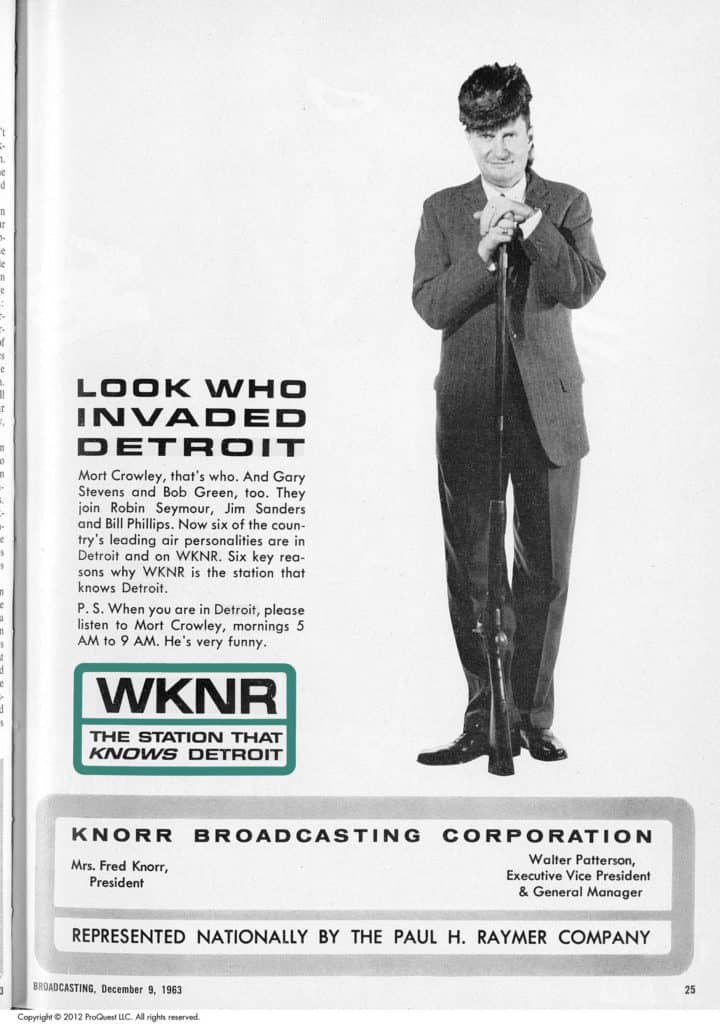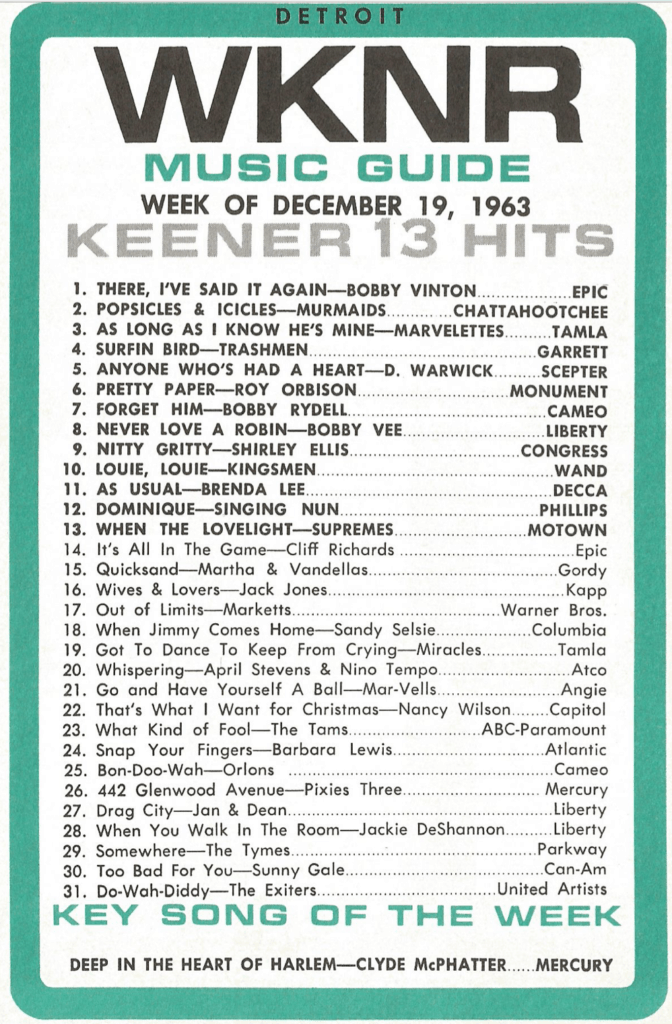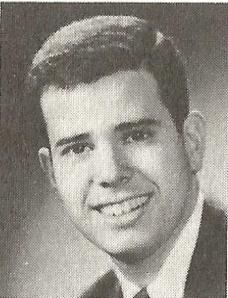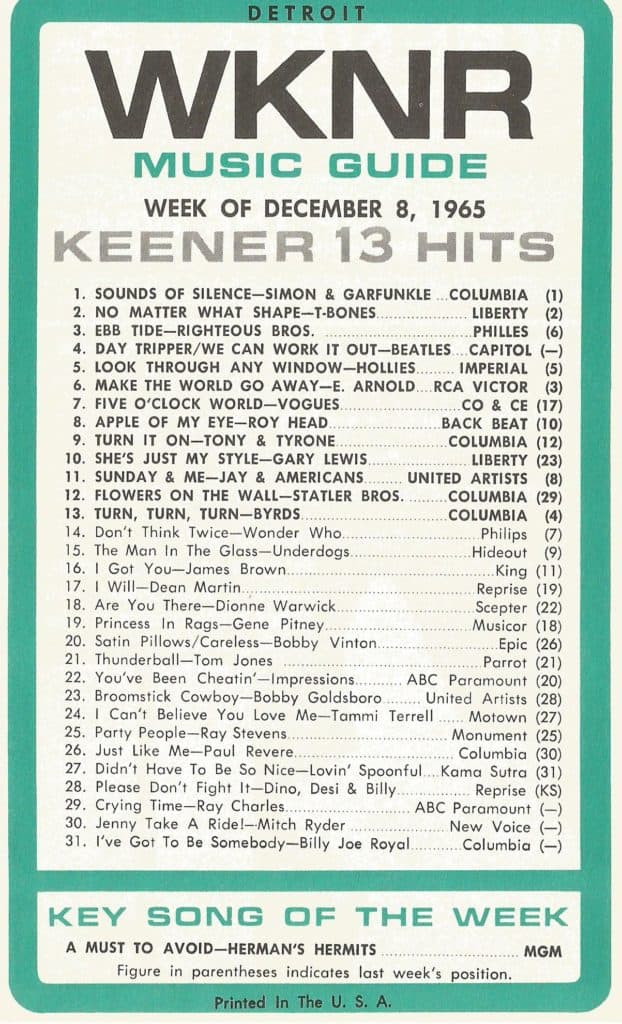Month: December 2017
When Keener Was Young
 By December of 1963, the Keener phoenominon had captivated the Motor City. The station was rocketing to the top of the Detroit radio ratings with the winning combination of entertaining announcers, a tight playlist of proven hits and an “intelligent flexibility” given to the jocks to experiment.
By December of 1963, the Keener phoenominon had captivated the Motor City. The station was rocketing to the top of the Detroit radio ratings with the winning combination of entertaining announcers, a tight playlist of proven hits and an “intelligent flexibility” given to the jocks to experiment.
Keener burst onto the scene in the midst of a changing American scene. We were still processing the assassination of John F. Kennedy. The Warren Commission was convened on December 3rd to investigate. Malcolm X gave his famous “Message to the Grass Roots” speech in Detroit. The first video tape instant replay was demonstrated by CBS TV Director, Tony Verna during a telecast of the Army/Navy football game. When Mort Crowley appeared in a full page ad for WKNR in the December 9th edition of Broadcasting Magazine, The Beatles had yet to explode on the American scene. I Saw Her Standing There & I Want to Hold Your Hand would be released on December 26th.
The December 19th edition of the WKNR Music Guide featured for acts from Berry Gordy’s labels. The Marvelettes, the Supremes, Martha and the Vandellas and the Miracles were all getting airplay. Rock and Roll was still intermingled with what would, in a year, be considered “middle of the road”. Bobby Vinton’s There I’ve Said It Again was at Number 1, juxtaposed with the garage grunge Surfin Bird from the Trashmen at number 4. Keener’s very first number one song, The Kingsmen’s Louie Louie was still in the top 10 and Chuck Berry’s The Twist was the top rated LP.
 On television, The Fugitive, The Patty Duke Show and Burke’s Law premiered on ABC. Petticoat Junction began its 7 year run on CBS. And Mutual of Omaha’s Wild Kingdom was finishing the first of 25 seasons on NBC. The Jetsons, Hawaiian Eye and Leave It To Beaver ended their prime time runs. Being close to the border, many of us were fans of the CBC’s Hockey Night in Canada. Gordie Howe and the Detroit Red Wings remained our favorite NHL team.
On television, The Fugitive, The Patty Duke Show and Burke’s Law premiered on ABC. Petticoat Junction began its 7 year run on CBS. And Mutual of Omaha’s Wild Kingdom was finishing the first of 25 seasons on NBC. The Jetsons, Hawaiian Eye and Leave It To Beaver ended their prime time runs. Being close to the border, many of us were fans of the CBC’s Hockey Night in Canada. Gordie Howe and the Detroit Red Wings remained our favorite NHL team.
It was a year of big screen blockbusters. Cleopatra, Alfred Hitchcock’s The Birds, It’s a Mad, Mad, Mad, Mad World and the Cinerama masterpiece, How The West Was Won were all doing boffo box office. A journeyman actor from England named Sean Connery appeared in the first installment of the James Bond series, Dr. No. Walt Disney had two entries in the top 10 grossing films of 1963, The Sword in the Stone and Son of Flubber.
Trolls, the Vac-u-Form and Kenner’s Easy Bake Oven were the most requested items on kids’ Christmas lists.
The Keener Key Men of Music in December of 1963 featured Mort Crowley in the morning, Gary Stevens, Bob Green, Robin Seymour, Jim Sanders and Bill Phillips, essentially the starting line-up the station had debuted when it flipped formats on Halloween night.
For those who grew up in Detroit in the 1960s, these memories are likely still fresh, from a time before our phones were in our pockets and radio was a secondary source for news and entertainment. We still mourned Kennedy, had yet to process the impact of the Vietnam war and believed that championship seasons were still ahead for the Wings, the Tigers and the Lions.
Radio was at the center of our collective consciousness, at home and in the car. And our relationships with the entertainers behind the mic that was just as important as the tunes we were humming.

Our aircheck of the week features Keener’s afternoon drive ace, Gary Stevens, recorded 7 months later, in July of 1964. Here he is at his zany best, featuring the Wollyburger, Keener Baseball, the British Invasion and more. Gary would graduate to the Big Apple, become a pirate radio legend in England and then move behind a desk as one of the most successful broadcast executives of the era.
WKNR – December 8, 1965
 In December of 1965, the Vietnam war was raging in Southeast Asia. St. Louis residents were still marveling at the recently completed Gateway Arch. Pillsbury introduced a new spokesman, someone they called the doughboy. We were still humming Beatle tunes from their film, Help!, in the wake of their 4th and final appearance on the Ed Sullivan Show. The Detroit Red Wings were just under 500 on the season, hoping to extend a 4 game winning streak as they prepared to host the New York Rangers at Olympia Stadium. We were driving cars with maize and blue Michigan license plates, watching Divorce Italian Style on the Channel 7 late movie, and on CBS, promos were running for the Saturday night debut of “A Charlie Brown Christmas”.
In December of 1965, the Vietnam war was raging in Southeast Asia. St. Louis residents were still marveling at the recently completed Gateway Arch. Pillsbury introduced a new spokesman, someone they called the doughboy. We were still humming Beatle tunes from their film, Help!, in the wake of their 4th and final appearance on the Ed Sullivan Show. The Detroit Red Wings were just under 500 on the season, hoping to extend a 4 game winning streak as they prepared to host the New York Rangers at Olympia Stadium. We were driving cars with maize and blue Michigan license plates, watching Divorce Italian Style on the Channel 7 late movie, and on CBS, promos were running for the Saturday night debut of “A Charlie Brown Christmas”.
Keener’s playlist reflected the eclectic tastes of a public that was still processing the evolution of rock and roll. Eddie Arnold and the Statler Brothers shared the field with Simon and Garfunkle, The Hollies and the Byrds. The British Invasion was in full swing with 4 acts in competition for ear time. The Underdogs were one of the Michigan garage bands who were seeking a second chart hit, while playing with the likes of Suzy Quatro and a Doug Brown and The Omens at Punch Andrews’s Hideout Night Clubs, the latter featuring a keyboard player from Ann Arbor by the name of Bob Seger. Toys like the Easy Bake Oven, GI Joe and Whamo’s Superball were among the most requested Christmas gifts. Advertisements for David Lean’s Dr. Zhivago were appearing in Detroit area newspapers. The film would open on December 22, joining The Greatest Story Ever Told and The Sound of Music as the year’s biggest blockbusters.
On the WKNR Music Guide, the number 1 song was Columbia Records’ reinvention from Simon and Garfunkle’s Wednesday Morning, 3AM LP. The Sounds of Silence had flopped a year earlier, inspiring producer Tom Wilson to bring bassist Joe Mack, drummer Buddy Salzman and guitarists Vinnie Bell and Al Gorgoni into the studio to overdub an electrified backing track. Done without the duo’s knowledge, this gave the record a competitive edge in a field filled with electric competition.
The Beatles’ Day Tripper & We Can Work It Out, became one of the station’s highest debuting double sides, opening at number 4. Power rotation also included iconic hits like the Hollies’ Look Through Any Window, James Brown’s signature I Got You and the Vogues ode to the working man, 5 O’clock World. The James Bond film Thunderball was still in circulation at neighborhood theiaters, along with Tom Jones’ theme song. And The Lovin Spoonful’s follow up to Do You Believe in Magic, You Didn’t Have to Be So Nice, was in it’s second week on the charts.

Keener was in it’s prime as a Detroit radio brand, as is showcased in this classic Bob Green aircheck. The Letter from Santa contest distributed Kodak’s Instamatic cameras across the Motor City. Lucky license numbers and The Keener Word of the day were perennial promotions. Bob’s conversational energy is both engaging and infectious, reflecting the Intelligent Flexibility maxim that was at the key ingredient Keener’s secret sauce. You can hear other familiar voices, including Paul Cannon and Ted Clark and classic Detroit advertisers are in evidence, including Gene Merollis Chevrolet. Behind it all is the classic WKNR reverb, crafted from a Hammond Organ spring by chief engineer, Jerry Martin.
Listening again to the Keener sound reminds us that, then as now, communications is about building relationships. We are engaged to the extent that we feel part of the magic. And in the mid 1960s few things were more engaging than WKNR.

